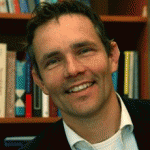Pieter Roelfsema
Endowed professor
The Vision and Cognition group is led by Pieter Roelfsema, also director of the Netherlands Institute for Neuroscience. Research of this group is directed at understanding cortical mechanisms of visual perception, memory and plasticity. One of our goals is to create a visual cortical prosthesis to restore vision in blind people.
Our main interest is to understand how a “thought” can emerge from the interactions between neurons in the brain. How does the exchange of electrical impulses between nerve cells allow us to think? We study this question in the visual cortex. When a new stimulus is presented to the visual system, neuronal activity is registered in early visual cortex and immediately propagated to higher visual areas. This initial “feedforward sweep” is followed by a phase of recurrent interactions within and between brain areas through feedback, lateral and horizontal connections. How do these different processing phases relate to thought processes?
Our research topic “perceptual organization” addresses the role of feedforward and feedback processes in visual perception. We are interested in perceptual organization: How does the brain code the image elements that belong to the same object and segregate these from elements that belong to other objects and the background? In previous work we found that image elements that belong to a single perceptual object are labeled in the visual cortex with enhanced neuronal activity. Psychologists call this labeling process “object-based attention” and we now aim to understand it at a mechanistic level. The remarkable finding that cognitive processes such as object-based attention can be monitored in visual cortex holds great promise for addressing other questions about thought processes in the brain.
In the topic “cognitive processing in early visual cortex” we investigate working memory, decision-making, consciousness and how multiple tasks may interfere with each other. We recently proposed a theory that aims to understand these cognitive processes within a unified reinforcement learning framework, where learning depends on feedback connections and reward prediction errors (Rombouts, Bohte & Roelfsema, 2012). Many of our projects address brain mechanisms in mice and monkeys.
However, the topic ”recording of single units in humans” is a unique collaboration with the VU university and the epilepsy center SEIN allowing us to also record single neuron activity in human patients who are implanted with electrodes in their brain as part of their treatment. Our work has potential to treat brain diseases and blindness. The new approaches for treatments are explored in the research topic “clinical applications”.